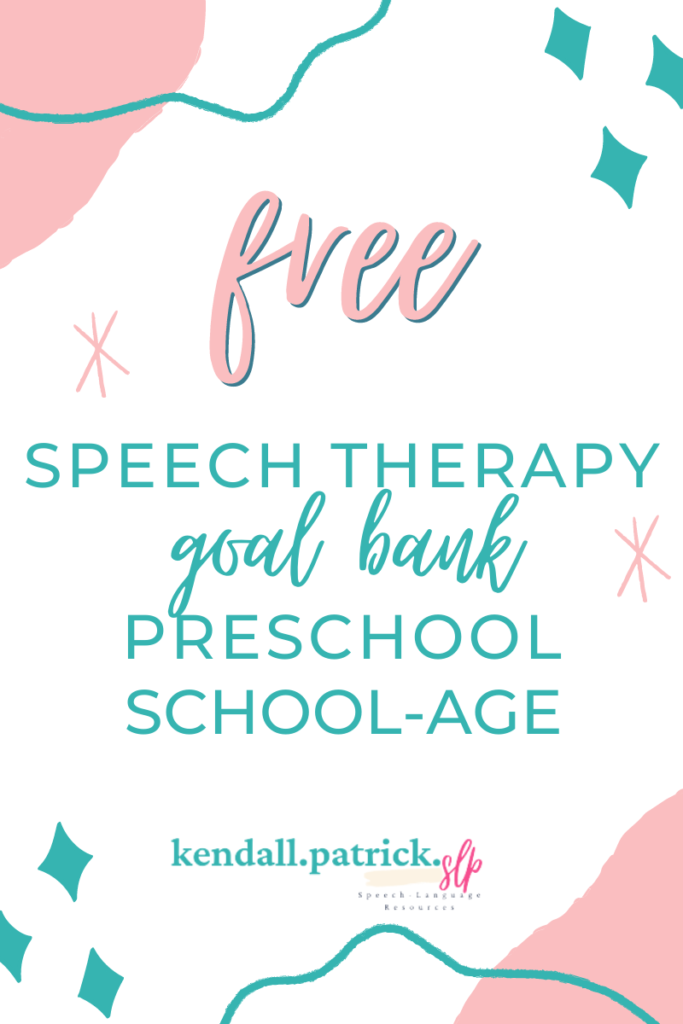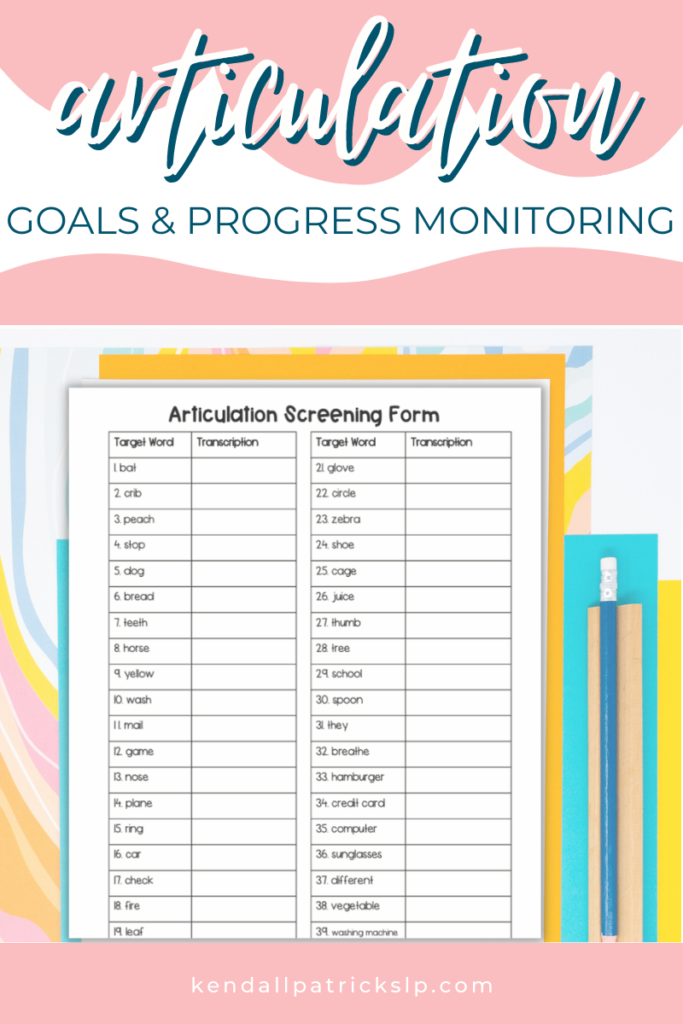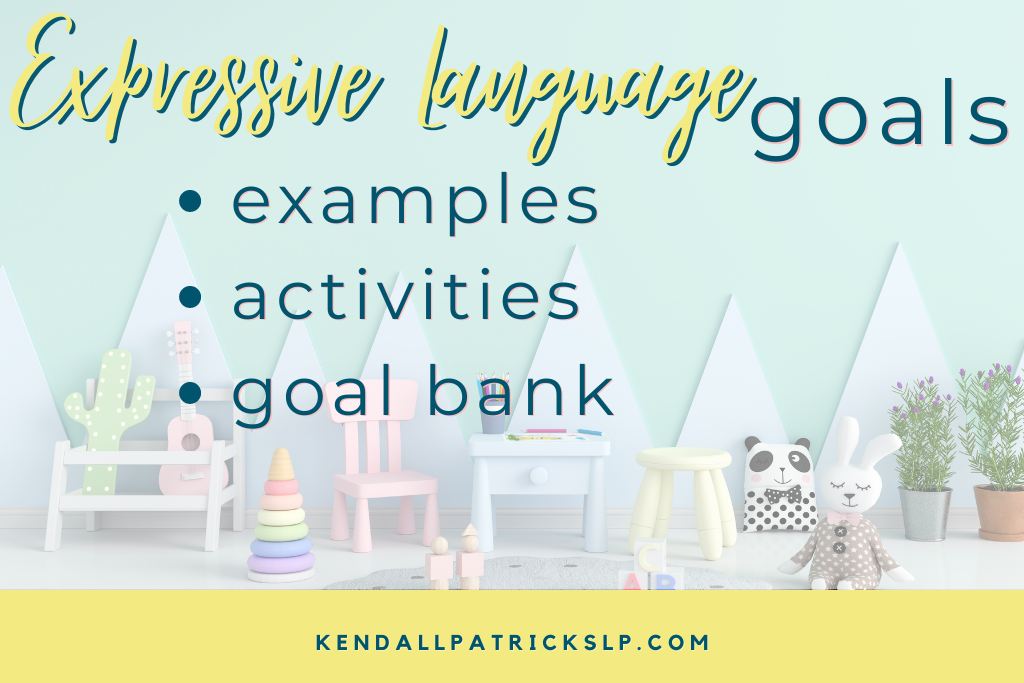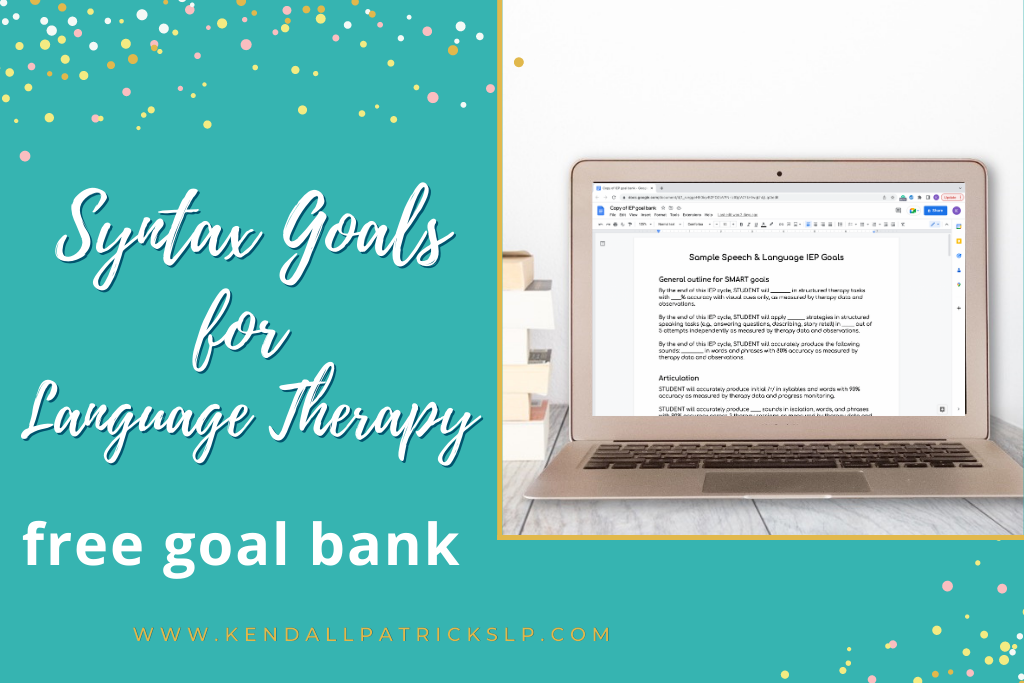Speech therapy goals can be tricky at times, but I’m here to share my best goal-writing and implementation tips. I find it easiest to have a few good core goals ready to go that I can then individualize depending on the student and their needs. Keeping a steady log of these goals makes goal writing so much easier. In this post, I have my favorite vocabulary speech therapy goals, as well as, speech therapy goals for fluency and Autism.
To sign up to receive all of my freebies, including my continuously growing goal bank, enter your info below!
Speech Therapy Goals
One thing I struggled with the most when I was starting out my first year was quickly and easily writing new IEP goals or updating old goals for students on my caseload. I tended to overthink and write and rewrite my goals until they were just right for my students, making it really hard on myself. For more on my journey as a school SLP, click here.
Now 10 years in, I have created a goal bank for myself of ideas in my head and on paper that are my go-to starting points when writing an IEP. These basic goals give me a good starting point when writing my IEPs and then all I have to do is go in and individualize based on that student’s needs. Now, is absolutely everything included here? No. Will there always be outliers or students with totally different needs? Absolutely. After all, this is the schools and we just never know what each year will bring. However, we can be pretty sure we’ll need a couple of key goals in the main areas we see year after year. For me, that would be Arctic, Vocabulary, Organization, Fluency, and Comprehension.

Speech Therapy Goals for Articulation
Below are some example goals I might write for articulation:
- By the end of this IEP cycle, STUDENT will accurately produce the following sounds: _________ in words and phrases with 80% accuracy as measured by therapy data and observations.
When working with students who have apraxia, I write my goals a little bit differently. Instead of focusing on specific sounds that I want the student to produce correctly, I might focus on placement and movement between placement at different syllable levels. Here are a couple of examples of how I might ride my apraxia goals:
- During structured therapy tasks, STUDENT will produce bilabial movement sequences given only a verbal model on 10 presentations with 70% accuracy as measured by therapy data and observation.
- During structured therapy tasks, STUDENT well accurately produced CVCVCV words (E.g., animal, tomato) with 80% accuracy as measured by therapy data and observation.
- During structured therapy tasks, STUDENT will accurately produce words with contrasting sound pairs (e.g., D/K, D/G, T/K, T/G with 80% accuracy as measured by therapy data and observation.
Progress Monitoring Speech Goals
Now, for my students with more severe articulation and/or phonological delays, that’s where it can get a little more tricky. If I were to try to go through every single sound error in every position, it would take forever. I also may not get great information about sound patterns and situations they may struggle/not struggle with – not to mention how incredibly frustrating it would be for the child. For that reason, I use a quick articulation/phonological progress monitoring tool (which also doubles as a screener) to get a snapshot of the child’s overall sound errors. It not only gives me a great place to start but also gives me a quick, visual, easy way to progress-monitor throughout the year and before IEP updates.

Speech Therapy Goals for Fluency
When writing fluency goals, I like to focus on the use of implementation of fluency strategies versus focusing on reducing the number of disfluencies in speech. I like to rate levels of success and mastery based on my students’ confidence in their speech and their ability to apply strategies on their own versus how many disfluencies they are actually producing. I would rather my student have a higher level of dysfluencies but be able to apply strategies when needed and with confidence rather than a student with fewer disfluencies, who is also less confident in their speech and/or unable to apply strategies independently.
Here are some of my example fluency goals:
- During structured therapy tasks, STUDENT will use fluency strategies (e.g., smooth speech, slow rate, full breath, etc.) and structured speaking tasks (e.g., answering questions, story retail, therapy games), with the use of visual cues and reminders, in four out of five opportunities.
- STUDENT will self-monitor his use of fluency strategies using an SLP-created rating scale in four out of five opportunities as measured by therapy data and observations.
Speech Therapy Goals for Expressive Language
“Language is a rule-governed behavior. It is defined as the comprehension and/or use of a spoken (i.e., listening and speaking), written (i.e., reading and writing), and/or other communication symbol system (e.g., American Sign Language).” (ASHA).
Language can be broken into 2 main areas, receptive and expressive. Receptive refers to listening and reading skills and expressive language refers to speaking and writing.
Speaking includes the following skill areas: appropriate use of phonological patterns, using morphemes correctly, using correct sentence structure, expressive vocabulary, and social language.
Writing included the following skill areas: spelling, grammar and sentence structure, writing vocabulary, and point of view or intended message/purpose.

Vocabulary Speech Therapy Goals
- During structured therapy tasks, STUDENT will apply an organizational strategy to provide 3 to 4 details when defining/describing presented vocabulary as measured by therapy data and/or student product.
- Given a sentence starter, STUDENT will express word relationships (e.g., category, parts of a whole, similarities/differences, color) with 80% accuracy.
- STUDENT will learn and use the following core vocabulary/classroom vocabulary (want, again, come, bad, no, help, me) using signs, approximation of signs, and/or an AAC board to indicate wants, needs, and/or action with 70% accuracy with visual, verbal and no more than 2 physical cues as measured by teacher checklists and therapy data.
Syntax Speech Therapy Goals
- STUDENT will express regular past tense verbs from pictures with 80% accuracy as measured by therapy data and observations.
- Given a sentence starter, STUDENT will describe a given picture using the appropriate subjective or objective pronoun with 85% accuracy as measured by therapy data and observations.

Pragmatic Speech Therapy Goals
I must admit, this is not my area of specialty and I am still learning A LOT. I highly recommend looking into some resources that are available to assist in writing neurodivergent goals for Autistic students. One example is this Goal Writing Course by Rachel Dorsey, available for ASHA CEUs.
Speech Therapy Goals – Autism
Make sure your goals are NOT focused on behaviors that may be uncomfortable for the student (e.g., eye contact) or that will force them to “fit in.”
Instead, focus on goals to help them advocate for themselves and express their needs as well as understanding a variety of communication styles and language (e.g., figurative, sarcasm, etc.).
I highly recommend following “bohospeechie” on Instagram, she shares some great information on neurodiversity and has some great sample goals like in this post here.

Speech Therapy Goals – Social Skills Group
Instead of what we would typically think of in a “social skills group,” try pairing students based on their special interests. This will give students a comfortable environment to be themselves, and instruction can be provided about a variety of communication types/styles and students may be given a choice as to how they would like to communicate/interact.
For more information on speech therapy goals:
Grammar Goals for Speech Therapy from The Pedi Speechie
4 Goals to Target Self-Monitoring in Speech Therapy from Kiwi Speech
SMART Goal Bank: Elementary from The Speech Bubble SLP
Don’t forget to sign up with your email address here to get access to my free library (growing all the time) full of some of my goodies made exclusively for my followers.
I hope you found some of these ideas helpful and can use one or more in your therapy room. Please leave a comment or shoot me an email if you want to share some of your favorite speech therapy goals and treatment ideas.


